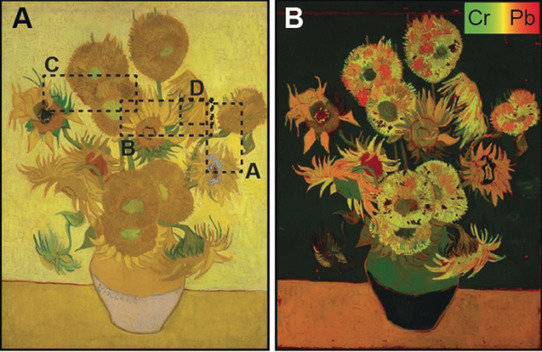Researchers from the Universities of Antwerp, Perugia and Delft together with museum staff have painstakingly examined Sunflowers by Vincent van Gogh (Van Gogh Museum, Amsterdam). He painted this iconic work, a composition dominated by yellow tints with some orange and blue accents, in 1889 in Arles, France. They found that some parts of the painting are more sensitive to color change due to light and humidity than others.The results of the investigation have been published in the scientific journal ‘Angewandte Chemie’.
F. Vanmeert (researcher at the University of Antwerp and main author of the study): “We developed a new, non-destructive method of chemical imaging based on X-ray diffraction that permits to identify all crystalline pigments with a high degree of certainty. We call it Macroscopic Scanning X-ray powder diffraction.”
In Sunflowers, when almost throughout the entire painting, the pigment Chrome Yellow is employed, the researchers observed that in the warm-yellow areas, a chemically very stable form of this pigment was used. Here, it is expected that in the coming decades, the paint will keep its original color without any problem.
Jaune citron
However, in the brighter parts of the flower petals and in the pale-yellow background, Van Gogh used the so-called ‘jaune citron’ (lemon yellow), which is a chrome yellow subtype that has a far stronger tendency towards darkening. Dr. Letizia Monico (University of Perugia): “This natural ageing process, which we could mimick in the lab, gives rise to the formation of an unattractive brown-olive coating covering the originally bright yellow paint.”
Van Gogh also used this light sensitive yellow pigment, mixed with darker colors, to paint the faded blooms in the painting. Dr. Geert van der Snickt (University of Antwerp, art conservation scientist): “Especially these areas will need to be monitored more closely in the future for spontaneously occurring color changes.”
Risk assessment
Prof. Koen Janssens (University of Antwerp): “The new scanning method permits for the first time to differentiate areas in a painting with lower or higher risks for color change. We expect this to be highly useful for the characterization of works by many artists.” Next to Sunflowers, the new method also has been employed recently to study well-known 17th century masterpieces such as Rembrandt’s Marten and Oopjen and Vermeer’s Girl with the Pearl Earring.
Prof. Joris Dik (Delft University of Technology): “Our investigation, together with other studies, provides the diagnostic information to make well-balanced decisions regarding the preservation and conservation of modern artworks, including Sunflowers.”
More information
Chemical Mapping by Macroscopic X‐ray Powder Diffraction (MA‐XRPD) of Van Gogh's Sunflowers: Identification of Areas with Higher Degradation Risk, Frederik Vanmeert, Ella Hendriks, Geert Van der Snickt, Letizia Monico, Joris Dik, Koen Janssens https://doi.org/10.1002/anie.201713293
Press release on similar research: Test developed which predicts degradation 20th century paintings
Contact Joris Dik: https://www.tudelft.nl/staff/j.dik/
Science Information Officer TU Delft Roy Meijer, r.e.t.meijer@tudelft.nl +31 15-2781751

